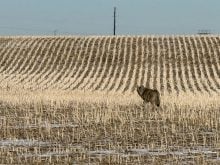RIDGEVILLE, Man., –ÊEric Wiebe could tell by early July his hopes of a bumper wheat harvest would be dashed by disease.
The fusarium head blight that decimated wheat crops on the southeastern Prairies last year had returned with a vengeance.
“I think it’s even worse than last year,” he said.
So in early July, Wiebe telephoned the Canadian Wheat Board to make sure officials knew they had a problem too.
Avoiding past mistakes
Wiebe said the last thing he needed as he headed into another difficult harvest was a repeat of the months of mixed marketing signals farmers got from the grain industry last fall when the disease first became an issue.
Read Also

Agritechnica Day 2: The future of tractor power, building quicker crop apps and large farms and tech
Agritechnica Day 2: The future of tractor power, building quicker crop apps with Syngenta and large farms and tech
Crop insurance wouldn’t write the crop off, but the Canadian Wheat Board initially refused to sell it.
And although stringent tolerances were in place downgrading grain and test results were inconsistent.
The marketing program eventually implemented late in the fall came too late for Wiebe and other farmers in the area.
They’d already sold it into U.S. livestock feed and milling markets.
“Being frustrated a little from last year, I told them maybe this year they’ve gotta’ clean up their act a little … come on out and have a look,” Wiebe said.
CWB drops in for a visit
Last week, Wiebe and his wife Shirley could barely believe their eyes as a convoy of more than a dozen vehicles containing high-level grain industry officials and invited media pulled into their farmyard.
“I was told they’d send a couple of people out,” he said.
The entourage sweeping through the region July 25 included the chief commissioners of the Canadian Wheat Board and the Canadian Grain Commission, senior grading and inspection officials, and representatives of the Manitoba Crop Insurance Corporation.
The impromptu inspection tour was assessing the extent of the fusarium infection first hand and letting farmers here know the board and regulatory officials are ready to confront the problem.
“Our marketing people are already searching out markets in the U.S. and in other parts of the world,” CWB chief commissioner Lorne Hehn said. “We’re going to do our best to market that product.”
Hehn conceded the board and industry were caught offguard by the fusarium outbreak last fall. Customers were panicking and officials were worried allowing the wheat from southern Manitoba into the system would damage Canada’s reputation for quality.
“Last year really was a learning experience for us,” Hehn said. “Obviously, we didn’t do everything right.”
Preparing for harvest
The board and the grain commission have already made some changes in preparation for this year’s harvest.
- Grade tolerances have been loosened, which will allow more grain with slight levels of infection into the higher grades.
- The board has asked the federal government to establish an initial price for the sample account containing up to 10 percent infected kernels. That’s in addition to the system implemented late last fall which allowed elevator agents to accept and clean the wheat to export standards for a discounted feed-wheat price.
- They are encouraging the industry to stop using the word “tombstone” to describe fusarium infected wheat. It concerns consumers, making the grain harder to market. “It has all kinds of negative connotations,” said Fraser Gilbert, chief of inspection services for the Canadian Grain Commission.
Wiebe liked what he heard. “I think they know they have a PR problem from last year. This year, they seem to want to deal with the problem.
“I think that’s the route they have to go, or they would lose people’s confidence completely.”














